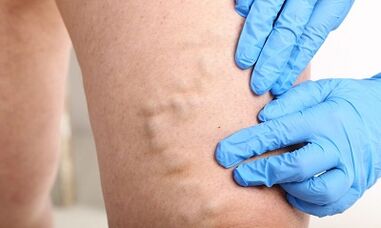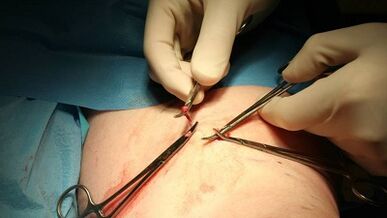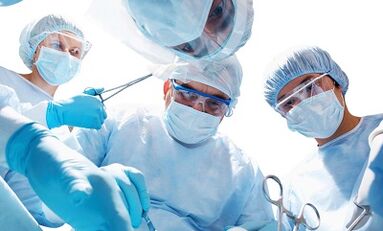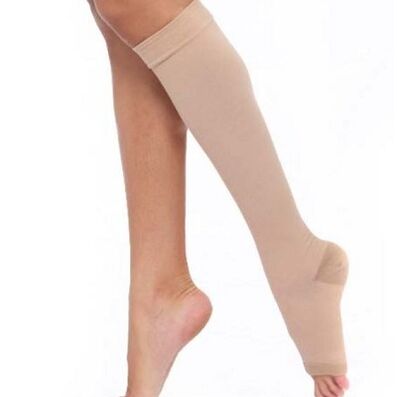The treatment of varicose veins with the help of medicines, physiotherapeutic and compression linen methods does not always lead to a positive result, especially in the third stage of the disease.In this case, the only way to help the patient is surgery.
For many patients, the operation is some kind of terrible procedure that they try to avoid in every way possible.Often, patients are pulled to the latter, do not resort to the doctor, treated with folkloric medicines.But if drugs do not help, unconventional medicine is even more.
An opportune operation for varicose veins can protect from many negative consequences.There is no need to be afraid.There are minimally invasive techniques that are characterized by a high degree of efficiency and low trauma.The choice of one or another method of surgical treatment is selected by a phlebologist.
Consider why methods are veins removed in the legs, how do they differ, what advantages and disadvantages do they have?
When do you need an operation for varicose veins?
The doctor recommends the operational path of venous insufficiency treatment in cases where, against the antecedents of drug therapy in the patient, the disease progresses rapidly.In other words, the operation in varicose veins remains the only way that will improve the patient's condition.
In surgical practice, cutting of veins from the lower extremities is performed in many ways.They all have their pros and cons, indications, they differ in technical characteristics and price.The cost consists of many points: the complexity of the operation, the doctor's qualification.Before the procedure, the patient needs to undergo an examination, take tests.
The diagnosis is necessary to exclude against probable indications.
The leg operation in the legs is performed in the following cases:
- Strong increase in subcutaneous veins;
- Advanced stage of varicose veins;
- Trophic ulcers at the lower ends as a result of varicose veins;
- Acute blood circulation in the legs as a result of which the patient has symptoms constantly: pain, gravity and discomfort, leg fatigue;
- Acute form of thrombophlebitia (inflammation of the venous walls).
Surgical intervention has absolute and relative -indications.The first includes malignant hypertension, coronary heart disease, pregnancy.Relative prohibitions include infectious and inflammatory processes in the body, dermatological manifestations at the intervention site, the patient's age in over 70 years.
Operation with varicose veins of the lower ends is a quick and effective way to eliminate pathology.The patient will return to ordinary life without suffering the suffering that the disease has caused.
Laser sclerosis and coagulation for varicose veins

VRV sclerosis is performed by different methods.Microosclerotherapy - The medications are introduced in the affected vessel that pastes the walls.This allows you to block a vein, will no longer move.The price of manipulation in a private clinic is about 5000 rubles.The duration of the procedure is 15 to 20 minutes.
A variety of procedures - ecosclerosis.This technique is used in cases where the affected vein diameter is above an inch.The operation is performed under the control of the ultrasound.With the help of manipulation, you can reduce the vase, restore normal blood flow.
Peny sclerotherapy involves the introduction of a substance, which, into contact with oxygen, is converted to foam.This method is considered the safest.Thanks to it, it is possible to level the blood circulation in the affected vessel.
Operation in varicose veins in the legs with a laser is a relatively new way to combat the disease.
Distinct characteristics of laser intervention:
- There is no need to make an incision, which prevents the formation of a scar or scar.
- Through a small puncture, a laser light is introduced into the vein, which studies the light waves.Using -o, dissolve a damaged ship.
- Recaps rarely develop - approximately 5% of patients.
Laser treatment rarely leads to complications, which act as an undisputed advantage.The least includes the cost of the procedure - of 35,000 rubles.This value does not include tests and exams, a medical appointment.
Combined phlebectomy and electrocoagulation endovazal
Combined phlebectomy is a common technique for varicose vein heating therapy.The cuts and perforations are minimal sizes.The operation is performed under epidural or general anesthesia.

To remove a painful vase under the skin, the surgeon makes an incision up to 15 mm.A special probe equipped with a tip is introduced through it.
After its extraction, the veins are designed.Remove the groin chart to the middle of the leg.With the help of small perforations, it is possible to consume small veins/ducts.
Upon completion of manipulation, the limbs are bandaged using an elastic bandage or the patient puts online underwear.
As in laser treatment, combined phlebectomy is not suitable for everyone as the cost of operation is high.
Endovasal electrocoagulation involves the removal of subcutaneous vessels.If you compare with radio frequency arrest, the technique will be more dangerous.
Removing for the treatment of varicose veins from the lower ends
Low removal ends - Traditional surgery for TRV legs.Veins removal with this method is practiced more often.This is mainly due to the fact that patients seek help to the late doctor and, in severe cases, minimally invasive techniques do not give the desired therapeutic effect.
The removal of varicose veins has several stages.In the first stage, the doctor makes a small cut in the groin.After that, they pull a vein where it flows into a deep vein in the thigh.Then the tributary mouths are distinguished and excised (depending on the indications, their number may vary from 1 to 7).
This action requires the doctor's attention, because if you forget a tax, it increases the risk of relaxed varicose veins in the patient several times.This is why this operation is performed only by highly qualified and experienced doctors.
The second stage of the intervention - make an ankle incision (inside only);The initial department of tributaries and large veins under the skin is distinguished.They are bandaged, after exciting.Then a special device is introduced into venous clearance, which is performed in the upper section.Through it, remove the whole vein.
Removal technique resources:
- Extended ducts, in other words, varicos are removed through small cuts;
- If the insolvent veins were found during the procedure, they will be bandaged after consecrating.
Affected areas that require removal are diagnosed with ultrasound.Removal is distinguished by a short duration of the rehab period compared to traditional operation to remove the veins.
Other methods of surgical treatment of varicose veins

Endoscopic dissection is a type of vein connection.The peculiarity of the technique is the use of endoscopic equipment, which allows intervention far from trophic disorders in the area of healthy tissue.
In surgical practice, two methods are used - with gas supply and not -Incumellings.It is believed that the technique with the supply of gas to the subfascial space is more effective.With this operation, a freer work cavity is formed, the risk of complications after surgery is reduced.
Crosurgery involves the removal of VRV blood vessels through the effects of a low temperature regime.The method is considered totally safe.But this operation is not performed in all clinics, as it requires modern equipment and high qualifications from the doctor who may manipulate.
With Criodestruction, there is a certain risk of complications.They are associated with a medical error - if the doctor incorrectly calculate the depth of frost, damage healthy tissues, which leads to various violations.
The radio frequency ablation of veins for varicose veins has the following resources:
- High efficiency, the risk of relapse of the disease is low.
- Lack of side effects.
- Small trauma.
- Minimum lesion of vessels.
With radiofrequency ablation, the veins destroy the inner wall of the vessel by radio frequency irradiation.As a result, the vein lumen closely.Surrounding (healthy) tissues do not suffer during manipulation.The operation is performed under local anesthesia at an outpatient base.
After the introduction of anesthesia, the veins are made in the leg area.A disposable catheter is introduced into the vase, which is equipped with an issuer.They promote the device to the place where subcutaneous flows in the deep vein.Then the catheter is slowly removed - during its extraction, the vase is radiated inside.
The injection site after the intervention is closed with a dressing and a compression sock is placed on the limb.
Characteristics of the rehabilitation period after leg surgery

After surgery at the lower ends, unpleasant consequences can develop.Side effects do not always develop and not in all patients.They are possible for any type of surgery for varicose veins.
The most common side effects include the appearance of bruises, seals under the skin.Patients complain of leg pain, severe swelling, impaired sensitivity in perforation sites or cuts.
Most of these symptoms occur independently within a month.Some phenomena can last up to 3-4 months.Edema and pain syndrome may disappear and then appear spontaneously with an increased load on the feet, against the bottom of the lesion when time changes.
After surgery, the patient needs:
- Wear compression underwear;
- Do not create heavy objects;
- Bring an active lifestyle (swimming, walk, cycling);
- Do the therapeutic massage of the legs from varicose veins;
- Balanced to eat.
As a relapse prevention of varicose expansion, it is necessary to control body weight, abandon shoes and tight clothing, take medications prescribed by the assistant doctor.In a sitting position, you can't throw your leg in your leg.During sleep, place a pillow under your feet so that the limbs are just above the body position.












































